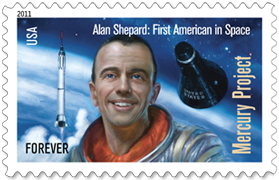It was the peak of the Cold War and the United States needed to carry off an impressive feat. Just three weeks earlier, on April 12, the Soviet Union (USSR) had sent the first human into space. That was Yuri Gagarin in the Vostok 1 capsule. Then, just a week after that impressive feat by the Russians, the United States suffered defeat in the poorly handled Bay of Pigs invasion of Cuba. To add to the history of that month, President John F. Kennedy received a memo the next week from Vice President Lyndon B. Johnson staying the only way the U.S. actually could come out on top in the Space Race would be beating the USSR to the Moon. Of course, getting to the Moon first was contingent on being able to launch an astronaut into space. America did that on May 5. We know now that Shepard flew in space that May and John Glenn flew into orbit around Earth on February 20, 1962. Later, Neil Armstrong would fly to to the Moon with Buzz Aldrin and Michael Collins in 1969, where he and Aldrin landed and walked July 21. American won the Moon Race. Alan Shepard. Navy Captain Shepard, 37 years old, had been an aircraft test pilot. He was one of seven Mercury Project astronauts. Shepard was in a tiny Mercury capsule atop a Redstone rocket when he flew in 1961 from Cape Canaveral. There was a real risk of explosion – other space rockets had blown up earlier – and nobody knew for sure if Shepard could survive the gravitational forces of liftoff and landing. He did. Shepard went on to command the Apollo 14 flight to the Moon, from which he and Edgar Mitchell walked on the Moon on Feb. 5, 1971. Along with scientific research on the lunar surface, Shepard hit two golf balls on the Moon. He retired from NASA and the Navy as a rear admiral in 1974. Shepard died of leukemia in 1998. Launch day. At 9:34 a.m. on May 5, 1961, Americans watching live on their black-and-white television sets saw the Redstone rocket lift off from the pad and lumber skyward. Seconds later, Shepard said via radio to the flight controllers, "Ah, Roger liftoff, and the clock is started." The engine shut down as planned at 2 minutes 42 seconds into the flight with Shepard traveling faster than any American had before: 5,134 mph. The capsule separated from the rocket, and Shepard was weightless. He took control, firing retro-rockets on NASA command, changing the capsule's position on all three axes. He had two tiny portholes and a periscope. He said later he could see the Florida coastline. In a matter of moments, as planned, the capsule was on its way toward splash down in the Atlantic Ocean near the Bahamas. Shepard had traveled 302 miles in about 15 minutes. He had flown to an altitude of 116 miles, which placed him and his capsule in space. The flight was suborbital – it did not orbit Earth. The flight compared with that of Yuri Gagarin in Vostok 1, which had flown for 108 minutes and orbited Earth at 17,500 mph. Back on Earth, Shepard was called an American hero as he received a ticker-tape parade in New York City. Twenty days after Shepard's flight, on May 25, 1961, President Kennedy told a joint session of Congress, "These are extraordinary times. I believe that this nation should commit itself to achieving the goal, before this decade is out, of landing a man on the Moon and returning him safely to the Earth." The nation made the commitment and reached that goal in 1969. |
